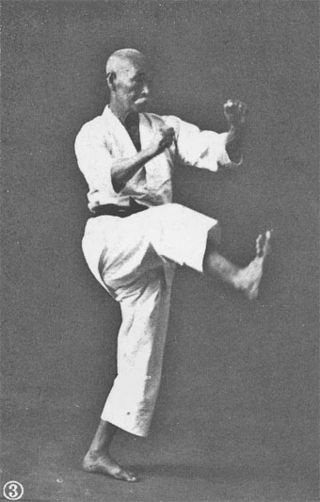
Karate (空手), also karate-do, is a martial art developed in the Ryukyu Kingdom. It developed from the indigenous Ryukyuan martial arts under the influence of Chinese martial arts. While, modern karate is primarily a striking art that uses punches and kicks, traditional karate training also employs throwing and joint locking techniques. A karate practitioner is called a karate-ka (空手家).

Kickboxing is a full-contact hybrid martial art and boxing type based on punching and kicking. Kickboxing originated in the 1950s to 1970s. The fight takes place in a boxing ring, normally with boxing gloves, mouth guards, shorts, and bare feet to favor the use of kicks. Kickboxing is practiced for self-defense, general fitness, or for competition. Some styles of kickboxing include: full contact karate, Muay Thai, Japanese kickboxing, Lethwei, Sanda, and Savate.

Taekwondo is a Korean martial art and combat sport involving punching and kicking techniques. The word Taekwondo can be translated as tae, kwon, and do. In addition to its five tenets of courtesy, integrity, perseverance, self-control and indomitable spirit, the sport requires three physical skills: poomsae (품새), kyorugi (겨루기) and gyeokpa (격파).
Randori (乱取り) is a term used in Japanese martial arts to describe free-style practice (sparring). The term denotes an exercise in 取り tori, applying technique to a random succession of uke attacks.

Shotokan is a style of karate, developed from various martial arts by Gichin Funakoshi (1868–1957) and his son Gigo (Yoshitaka) Funakoshi (1906–1945). Gichin Funakoshi was born in Okinawa and is widely credited with popularizing "karate do" through a series of public demonstrations, and by promoting the development of university karate clubs, including those at Keio, Waseda, Hitotsubashi (Shodai), Takushoku, Chuo, Gakushuin, and Hosei.
Kyokushin (極真) is a style of karate originating in Japan. It is a full-contact style of stand-up fighting and is rooted in a philosophy of self-improvement, discipline, and hard training.

Full contact karate is any format of karate where competitors spar full-contact and allow a knockout as winning criterion.
Isshin-Ryū is a style of Okinawan karate created by Tatsuo Shimabuku in approximately 1947/1948. Isshin-Ryū karate is largely a synthesis of Shorin-ryū karate, Gojū-ryū karate, and kobudō. The name means, literally, "one heart method". In 1989 there were 336 branches of Isshin-ryū throughout the world, most of which were concentrated in the United States.

The front kick in martial arts is a kick executed by lifting the knee straight forward, while keeping the foot and shin either hanging freely or pulled to the hip, and then straightening the leg in front of the practitioner and striking the target area. It is desirable to retract the leg immediately after delivering the kick, to avoid the opponent trying to grapple the leg and to return to stable fighting stance.
Shuri-ryū (首里流) karate is an eclectic martial arts system developed by Robert Trias (1923–1989), reportedly the first Hispanic to teach a form of karate in the mainland United States, and also opened his public first dojo in 1946 in Phoenix, Arizona.

Enshin kaikan (円心会館) is a style of "full contact karate", or knockdown karate, founded in 1988 with dojo and students in various countries around the world.
Ippon is the highest score a fighter can achieve in a Japanese martial arts ippon-wazari contest, usually kendo, judo, karate or jujitsu.
The Karate World Championships, also known as the World Karate Championships, are the highest level of competition for karate organized by the World Karate Federation (WKF). The competition is held in a different city every two years. Championships in the 2000s included Madrid in 2002, Monterrey in 2004, Tampere in 2006, Tokyo in 2008, and Belgrade in 2010. The competition was initially riddled with controversy regarding karate styles and the ruleset.
Terutomo Yamazaki is a Japanese karateka from the Kyokushin Kaikan (極真会館) and professional lightweight kickboxer. He is the founder of Gyakushin-Kai (逆真会館) and a Director of Karate in Japan. He presides over the International Budo Karate Organization Gyakushin-Kai from the headquarters of the organization (honbu) in Ōmiya-ku, Saitama, Japan. His title as head of the Gyakushin-Kai organization is “Kancho”.

Waza-ari is the second highest score a fighter can achieve in a Japanese martial arts ippon or waza-ari contest, usually judo, karate, or jujutsu.

Ashihara kaikan is a modern full contact street karate developed from Kyokushin karate by Hideyuki Ashihara with influences from various martial arts including Muay Thai, Pankration, and Jujutsu with an emphasis on Sabaki, using footwork and techniques to turn an opponent's power and momentum against them and to reposition oneself to the opponent's "blind" spot. The style is focused on practical application in a real fight including multiple attackers.
Shidōkan (士道館) is an eclectic style of knockdown karate, founded by Yoshiji Soeno. Established in 1978, its governing body is the World Karate Association Shidokan, with its headquarters located in Ito City, Shizuoka Prefecture. Currently, it has branches in 68 countries.

The Byakuren Kaikan or Byakuren Karate is a full contact karate style founded in 1984 by Sugihara Masayasu.
Karate was an event held in the 2020 Summer Olympics in Tokyo, Japan. It was the debut appearance of karate at the Summer Olympics. Karate was one of four optional sports added to the Olympic program specifically for 2020, rather than as a permanent sport. After it was announced not to be included in 2024, in August 2022 it was announced that karate had made the shortlist for inclusion in the 2028 Games, although it was ultimately not selected.

Andrii Zaplitnyi is a Ukrainian karateka competing in the kumite 75 kg division. Champion of the European Games 2023, European karate champion, 3rd place World Championship. He is currently ranked 3rd in the kumite 75 kg division. He is Master of Sports of Ukraine of international class.














